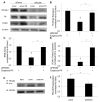Atheroprone hemodynamics regulate fibronectin deposition to create positive feedback that sustains endothelial inflammation
- PMID: 20378855
- PMCID: PMC2891748
- DOI: 10.1161/CIRCRESAHA.109.216283
Atheroprone hemodynamics regulate fibronectin deposition to create positive feedback that sustains endothelial inflammation
Abstract
Rationale: The extracellular matrix protein fibronectin (FN) is focally deposited in regions of atherosclerosis, where it contributes to inflammatory signaling.
Objective: To elucidate the mechanism by which FN deposition is regulated by local shear stress patterns, its dependence on platelet-endothelial cell adhesion molecule (PECAM)-1 mechanotransduction and the role this pathway plays in sustaining an atheroprone/proinflammatory phenotype.
Methods and results: Human endothelial cells were exposed in vitro to atheroprone or atheroprotective shear stress patterns derived from human carotid arteries. Onset of atheroprotective flow induced a transient increase in FN deposition, whereas atheroprone flow caused a steady increase in FN expression and integrin activation over time, leading to a significant and sustained increase in FN deposition relative to atheroprotective conditions. Comparing FN staining in ApoE(-/-) and ApoE(-/-)PECAM(-/-) mice showed that PECAM-1 was essential for FN accumulation in atheroprone regions of the aortic arch. In vitro, small interfering RNA against PECAM-1 blocked the induction of FN and the activation of nuclear factor (NF)-kappaB by atheroprone flow, which was rescued by the addition of exogenous FN. Additionally, blocking NF-kappaB activation attenuated the flow-induced FN expression. Small interfering RNA against FN significantly reduced NF-kappaB activity, which was rescued by the addition of exogenous FN.
Conclusions: These results indicate that FN gene expression and assembly into matrix fibrils is induced by atheroprone fluid shear stress. This effect is mediated at least in part by the transcription factor NF-kappaB. Additionally, because FN promotes activation of NF-kappaB, atheroprone shear stress creates a positive feedback to maintain inflammation.
Figures






References
-
- Ross R. Atherosclerosis--an inflammatory disease. The New England journal of medicine. 1999;340:115–126. - PubMed
-
- Dai G, Kaazempur-Mofrad MR, Natarajan S, Zhang Y, Vaughn S, Blackman BR, Kamm RD, Garcia-Cardena G, Gimbrone MA., Jr Distinct endothelial phenotypes evoked by arterial waveforms derived from atherosclerosis-susceptible and -resistant regions of human vasculature; Proceedings of the National Academy of Sciences of the United States of America; 2004. pp. 14871–14876. - PMC - PubMed
Publication types
MeSH terms
Substances
Grants and funding
LinkOut - more resources
Full Text Sources
Medical
Molecular Biology Databases
Miscellaneous

